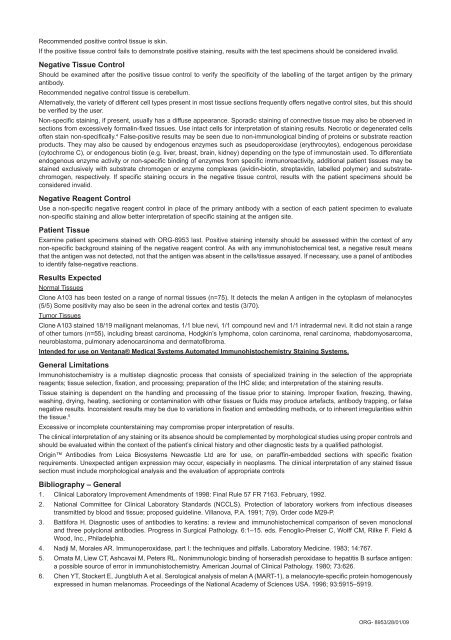Novocastratm Origintm Mouse Monoclonal Antibody Melan A ...
Novocastratm Origintm Mouse Monoclonal Antibody Melan A ...
Novocastratm Origintm Mouse Monoclonal Antibody Melan A ...
Create successful ePaper yourself
Turn your PDF publications into a flip-book with our unique Google optimized e-Paper software.
Recommended positive control tissue is skin.<br />
If the positive tissue control fails to demonstrate positive staining, results with the test specimens should be considered invalid.<br />
Negative Tissue Control<br />
Should be examined after the positive tissue control to verify the specificity of the labelling of the target antigen by the primary<br />
antibody.<br />
Recommended negative control tissue is cerebellum.<br />
Alternatively, the variety of different cell types present in most tissue sections frequently offers negative control sites, but this should<br />
be verified by the user.<br />
Non-specific staining, if present, usually has a diffuse appearance. Sporadic staining of connective tissue may also be observed in<br />
sections from excessively formalin-fixed tissues. Use intact cells for interpretation of staining results. Necrotic or degenerated cells<br />
often stain non-specifically. 4 False-positive results may be seen due to non-immunological binding of proteins or substrate reaction<br />
products. They may also be caused by endogenous enzymes such as pseudoperoxidase (erythrocytes), endogenous peroxidase<br />
(cytochrome C), or endogenous biotin (e.g. liver, breast, brain, kidney) depending on the type of immunostain used. To differentiate<br />
endogenous enzyme activity or non-specific binding of enzymes from specific immunoreactivity, additional patient tissues may be<br />
stained exclusively with substrate chromogen or enzyme complexes (avidin-biotin, streptavidin, labelled polymer) and substratechromogen,<br />
respectively. If specific staining occurs in the negative tissue control, results with the patient specimens should be<br />
considered invalid.<br />
Negative Reagent Control<br />
Use a non-specific negative reagent control in place of the primary antibody with a section of each patient specimen to evaluate<br />
non-specific staining and allow better interpretation of specific staining at the antigen site.<br />
Patient Tissue<br />
Examine patient specimens stained with ORG-8953 last. Positive staining intensity should be assessed within the context of any<br />
non-specific background staining of the negative reagent control. As with any immunohistochemical test, a negative result means<br />
that the antigen was not detected, not that the antigen was absent in the cells/tissue assayed. If necessary, use a panel of antibodies<br />
to identify false-negative reactions.<br />
Results Expected<br />
Normal Tissues<br />
Clone A103 has been tested on a range of normal tissues (n=75). It detects the melan A antigen in the cytoplasm of melanocytes<br />
(5/5) Some positivity may also be seen in the adrenal cortex and testis (3/70).<br />
Tumor Tissues<br />
Clone A103 stained 18/19 mailignant melanomas, 1/1 blue nevi, 1/1 compound nevi and 1/1 intradermal nevi. It did not stain a range<br />
of other tumors (n=55), including breast carcinoma, Hodgkin’s lymphoma, colon carcinoma, renal carcinoma, rhabdomyosarcoma,<br />
neuroblastoma, pulmonary adenocarcinoma and dermatofibroma.<br />
Intended for use on Ventana® Medical Systems Automated Immunohistochemistry Staining Systems.<br />
General Limitations<br />
Immunohistochemistry is a multistep diagnostic process that consists of specialized training in the selection of the appropriate<br />
reagents; tissue selection, fixation, and processing; preparation of the IHC slide; and interpretation of the staining results.<br />
Tissue staining is dependent on the handling and processing of the tissue prior to staining. Improper fixation, freezing, thawing,<br />
washing, drying, heating, sectioning or contamination with other tissues or fluids may produce artefacts, antibody trapping, or false<br />
negative results. Inconsistent results may be due to variations in fixation and embedding methods, or to inherent irregularities within<br />
the tissue. 5<br />
Excessive or incomplete counterstaining may compromise proper interpretation of results.<br />
The clinical interpretation of any staining or its absence should be complemented by morphological studies using proper controls and<br />
should be evaluated within the context of the patient’s clinical history and other diagnostic tests by a qualified pathologist.<br />
Origin Antibodies from Leica Biosystems Newcastle Ltd are for use, on paraffin-embedded sections with specific fixation<br />
requirements. Unexpected antigen expression may occur, especially in neoplasms. The clinical interpretation of any stained tissue<br />
section must include morphological analysis and the evaluation of appropriate controls<br />
Bibliography – General<br />
1. Clinical Laboratory Improvement Amendments of 1998: Final Rule 57 FR 7163. February, 1992.<br />
2. National Committee for Clinical Laboratory Standards (NCCLS). Protection of laboratory workers from infectious diseases<br />
transmitted by blood and tissue; proposed guideline. Villanova, P.A. 1991; 7(9). Order code M29-P.<br />
3. Battifora H. Diagnostic uses of antibodies to keratins: a review and immunohistochemical comparison of seven monoclonal<br />
and three polyclonal antibodies. Progress in Surgical Pathology. 6:1–15. eds. Fenoglio-Preiser C, Wolff CM, Rilke F. Field &<br />
Wood, Inc., Philadelphia.<br />
4. Nadji M, Morales AR. Immunoperoxidase, part I: the techniques and pitfalls. Laboratory Medicine. 1983; 14:767.<br />
5. Omata M, Liew CT, Ashcavai M, Peters RL. Nonimmunologic binding of horseradish peroxidase to hepatitis B surface antigen:<br />
a possible source of error in immunohistochemistry. American Journal of Clinical Pathology. 1980; 73:626.<br />
6. Chen YT, Stockert E, Jungbluth A et al. Serological analysis of melan A (MART-1), a melanocyte-specific protein homogenously<br />
expressed in human melanomas. Proceedings of the National Academy of Sciences USA. 1996; 93:5915–5919.<br />
ORG- 8953/28/01/09
















